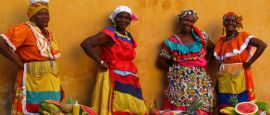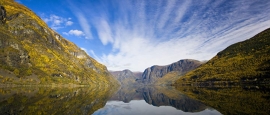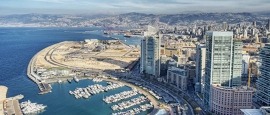Climb the snow-capped Nevado del Ruiz: the 5,400m (17,717ft) peak is one of five permanently white-tipped volcanoes in Los Nevados National Park in the coffee region. Volcanic eruptions and earthquakes are regular occurrences here, though hikers enjoy the benefits of hot springs bubbling from the mountainsides. Guided treks are available from Manizales, one of the main hubs for visitors.
Colombia things to see and do
Tourist offices
Address: Calle 28A, No 13a-15, Piso 35, Bogotá, Colombia
Tel: +57 1 419 9450.
Opening Hours: Mon-Fri 0830-1700.
www.colombia.travel
Cycle or skate along car-free roads in central Bogotá on Sundays and holidays from 0700 to 1400, when 121km (75 miles) of the capital's streets are transformed into ciclovías (cycleways). Cycling-mad Colombia also has many ideal countryside routes, where mountain-biking and touring groups operate, including the temperate hillsides of the Zona Cafetera.
The colonial city of Zipaquirá is home to one of Colombia’s most popular attractions: a cathedral made of sale. Inaugurated in 1954, the underground church was hewn out of the mountain, deep within a salt mine near the city. Stalactites and specks of salt mingle with crosses and chapels to create a glowing spiritual atmosphere.
Take a jungle tour into the Amazon basin, which covers almost one-third of Colombia's territory. Boat trips depart from Leticia, in the Amazonas region to the nearby Amacayu National Park. Tours often include visits to indigenous tribes, sleeping in hammocks slung in straw-roofed malocas. The park is prone to closure following flooding, so check the latest information before departure.
With its stunning Caribbean location, the Tayrona National Park, close to Santa Marta, is one of the country's most popular parks. Spilling down from the northern slopes of the Sierra Nevada, it boasts coral reefs, sheltered bays, beautiful beaches, mangroves and wildlife-rich jungle. Get back to nature but don’t forget to pack your mosquito repellent.
Colombia offers a host of adventures for watersports lovers. Dive into the species-rich tropical waters of the UNESCO Seaflower Biosphere Reserve around San Andrés and Providencia. Other diving hotspots include the Islas del Rosario and Tayrona National Park. Raft the rapids on the Rio Negro in Cundinamarca and Fonce or kayak through the Chicamocha canyon in Santander.
Perched high in the Andes, the Colombian capital has an attractive mix of swish, modern neighbourhoods and windy streets overlooked by a mountainous vantage point (take the cable car up for great sunset views). Historical landmarks include the Capitolio Nacional and the cathedral on the main square, Plaza Bolivar. The star attraction, however, is the magnificent Gold Museum; its collection of pre-Columbian treasures is probably the finest in South America.
Fly to the tropical islands of San Andrés and its smaller sibling Providencia, two of Colombia’s most idyllic retreats, off the Caribbean coast. San Andrés was once the headquarters of the English pirate Captain Henry Morgan, with an offshore underwater cave reputed to be the site of his buried loot, and a nearby museum dedicated to local pirate lore.
One of Latin America’s most famous modern artists is Colombian Fernando Botero and visitors can wander among some of his characteristically voluptuous sculptures in the Plaza Botero, found in Bogotá’s La Candelaria. Around 120 of his paintings, as well as an impressive collection of Impressionist and modern art, are on display at the Museo Botero, also in La Candelaria.
Once a year, the industrial port of Barranquilla is transformed by one of the world’s biggest carnivals, second in size only to Rio de Janeiro’s event, and attracting visitors from around the globe. The main parades take place on the four days preceding Ash Wednesday, when the city streets are filled with thousands of costumed dancers, gyrating to the lively Caribbean rhythms.
A great town to visit en route to the south, Popayán is a vision of beautifully restored colonial architecture. Wander around the stunning streets and visit the beautiful churches, in particular Belén, which is perched on a hilltop and provides lovely views. Easter week processions here are particularly impressive and nearby are the pre-Columbian tombs in Tierradentro National Park.
Weave your way around more than 500 mysterious pre-Columbian stone statues and tombs in one of South America's most fascinating archaeological sites, San Agustín, in the southern Cordilera Central. Thought to date back some 3,000 years, this is the largest group of religious monuments and megalithic sculptures on the continent, relating to one of the earliest Andean settlements.
Colombia’s capital of salsa, the southern city of Cali is the place to go for all-night hip swinging. Dress to impress in the salsa clubs, many of which are found in the Barrio Juanchito, which gets going at 0200 and doesn’t stop until 0600. During the day explore San Antonio, the historical centre, or visit one of the highly rated museums.
One of South America’s prettiest colonial towns, charming Cartagena brims with history and is more than a little easy on the eye. The former home of author, Gabriel Garcia Marquez, visitors can take literary tours of the city, explore cobbled streets and sip coffee beneath beautiful blooms of bougainvillea. Once you’ve had your culture fix, take a trip to nearby coral islands, which abound with beaches, labyrinthine mangrove forests and colourful coral reefs.
Climb high into the jungle-covered Sierra Nevada de Santa Marta to the archaeological ruins of the Ciudad Perdida (‘Lost City’), discovered in 1976. This six-day trek is not for the faint-hearted, but is one of Colombia’s most rewarding adventures.
Colombia is famous for its coffee, and you can take a trip to this region of gently rolling hillsides, visiting the coffee haciendas and hiking, cycling or horseback riding through the countryside, trying different coffees along the way. The triangle is made up of Quindío, Caldas and Risaralda departments, with plenty of towns in the area in which to stay.
Known simply as Mompox, this tiny colonial gem is off the main tourist path due to its comparative inaccessibility, but it’s worth the trip by bus and boat. With its well-preserved architecture, the town has a sleepy, friendly feel about it. Simon Bolivar was one of its most famous residents, and Gabriel Garcia Márquez based his classic, One Hundred Years of Solitude, on the town.
The second largest city in Colombia, Medellín is modern and vibrant, having shaken off its association with violent drug cartels. Today, the pleasantly warm ‘City of Eternal Spring’ has a lively young community of university students, with a lot of time for the arts. Visit the museums and parks, learn to tango and embrace the serious nightlife on offer. The annual Festival of Flowers in August is superb.
Do you have any Feedback about this page?
© 2025 Columbus Travel Media Ltd. All rights reserved. No part of this site may be reproduced without our written permission, click here for information on Columbus Content Solutions.








 You know where
You know where